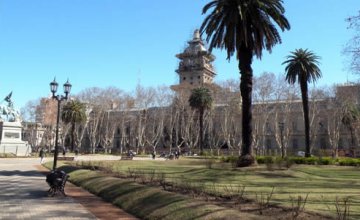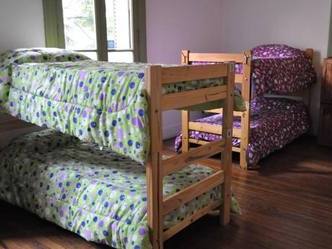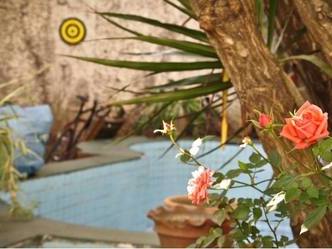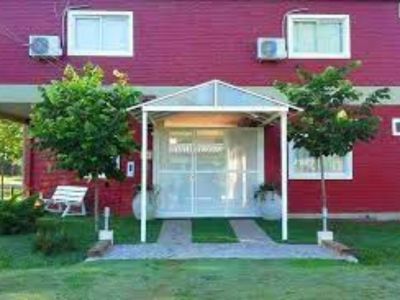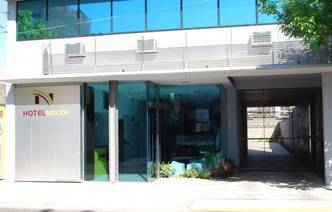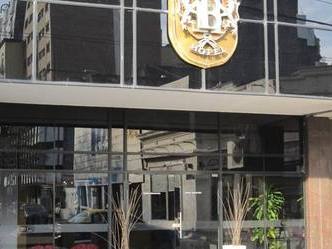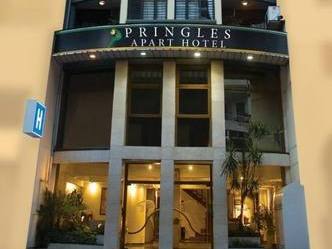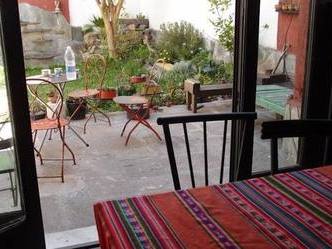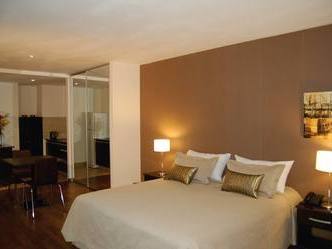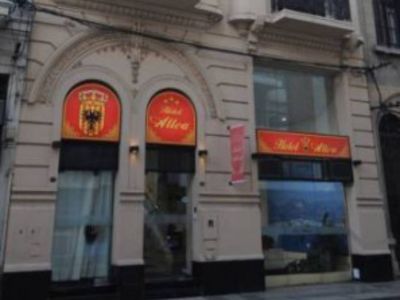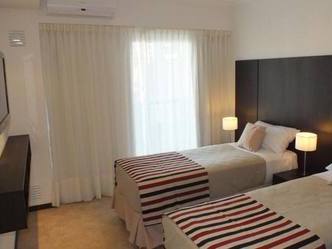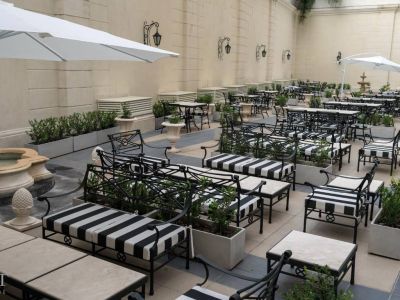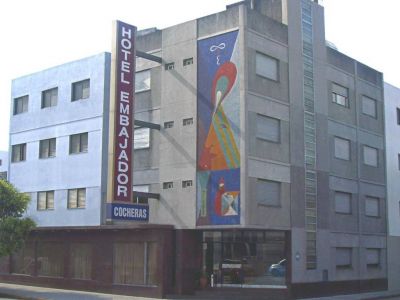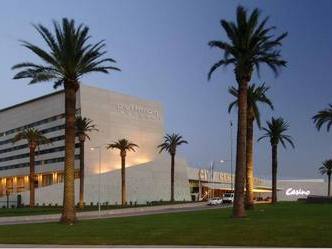We woke up late, as expected after the long trip we had taken all the way down from San Martín de los Andes. Despite that, an intense and whitish fog seemed unwilling to leave the city and remained still amidst the city of Rosario.
After some loafing about, we resolved to put an end to our laziness. A hot shower and a cup of black coffee was just what we needed to gather courage and go out to see the cool morning in Rosario.
As if by magic, the mist cast upon the city started to rise, and with it, the brightness, the sounds and the smells typical of the metropolis began to shine as we went about. Much to our surprise, it was not as cold as we had imagined. In fact, a beam of sunlight percolating through the grayish clouds contributed to a certain degree of warmth.
Riding a bike around the City
After having lunch in the very exclusive Muelle 1, a restaurant owned by Marcelo Santana at La Fluvial –the heart of the Rosario waterfront– we decided that a “bike tour” would be the best alternative to get to know the city better, and at the same time practice some sport.
A local tourist operator was in charge of providing us with the bicycles. That is how we met Gabriela, who showed us around the most important and tourist aspects of the area.
We set off. As expected, the first sight we caught was the Parque Nacional a la Bandera, in honor to the national flag. “It is possible to find part of the urban past in this place, as the harbor, the railway and commercial activities used to come together at this point” –Gabriela explained.
We knew that the sailing boats, the steam boats and the coastal and overseas vessels would berth on the bank of the river. With the economic growth, the first quay and the Customs office were built.
The bicycles we used for the ride were all-terrain, with gear shift. Every fifteen minutes, the guide would recommend that we drank some water. This way, our bodies would not be exhausted.
Along the Belgrano Avenue, we began to border the riverfront. In the XIX century, this area was nothing else than a sandy and rocky beach inlet, were the dwellers would load and unload products from the crafts berthing at the harbor. In the early XX century, the city mayor, Luis Lamas, proposed “to embellish the city” and laid out an avenue on the existing track. We rode along that beautiful avenue ornamented by a continuous line of silk trees, wild indigos, jacaranda trees and coral trees.
The Lungs of the Metropolis
Surrounded by so many elements of nature, a considerably large building caught our attention. “That is the Customs’ building” –our guide disclosed as if she had guessed what we were going to ask her– “It is French style and dates from 1903. Its stories adapt to the irregular form of the block and to the drops presented by Urquiza Street and Belgrano Avenue, where the main entrance to the building is located.”
We continued with our ride at good pace and enjoying the benefits of the waterfront and the magnificent sights that the Paraná River was giving us.
We quickly passed by the Museo de Arte Contemporáneo, located in an ancient barn which had been recycled in 1995 to become a Cultural Center oriented to the new trends. In this museum, a major participation of the youth is intended through the presentation of various shows, exhibitions, information and research seminars, art, design and language. The bright spectacular colors in which the museum is painted, give it a distinctive feature amidst the parks surrounding it.
In this area, we made a stop to have a few minutes’ rest before we continued with the tour. Sitting on a wooden bench, we recovered our energy and relaxed our senses watching how the sailing boats slowly moved along the river from one point to another.
We resumed our march and passed by the Parque de España. This green space is the result of a joint undertaking by the Argentinian government and the Spanish community in Argentina. In the inner part, the park has a cultural development with a theatre room, a lecture room and three tunnels used as art galleries.
Bordering the waterfront, we also watched the Isla de los Inventos (Island of Inventions) and the Cerealera Unidad 6 silos, located on the harbor.
Farther on, we passed by the Club Atlético Rosario Central football stadium. Gabriela told us that the club had been founded in 1889 by a group of English railway workers. “Its first name was Central Argentino Railway Athletic Club and it was meant for the practice of football and cricket. Its stadium was inaugurated in October 1929, and was remodeled for the 1978 World Cup to seat 47,000 spectators” –the guide explained.
In the facilities of the club, there is also an Olympic swimming-pool, camping site and access to the river below the avenue.
From the “Arroyito Giant”, as this World cup stadium is commonly known, we left along the riverside promenade. A beautiful green space welcomed us: the Alem Park, former Ludueña Park. Its present name comes from the monument in honor of Leandro Alem, symbolizing, with a steel bar, its governing ideas during his public duties –“Let it be broken but not bent”. In the premises, there is a development area containing swimming-pools and various piers, marinas and places to taste typical and foreign dishes.
We also passed by the Usina Termoeléctrica Sorrento, which provides electric power to an important part of the city.
Along the way, we saw various restaurants where you can taste river fish.
This tour includes several resorts by the river, such as the Balneario Municipal La Florida and the Catalunya I and Catalunya II promenades.
Bridges, Museums, Fairs and something else …
We got to a panoramic point, where we stopped to watch the Rosario-Victoria Bridge. This engineering work took five years to be built. “The suspension bridge span is 608 meters long and 22 meters wide and it is made up of two main towers 126 meters high each. It has four lanes and there is a height of 51 meters under it for navigation.” This bridge represented a huge leap for communication within the Atlantic-Pacific corridor, vital for the success of MERCOSUR.
From this point, we started our way back to the center of the city. We passed through the legendary Pichincha neighborhood, very well known for providing steady and enthusiast male customers with services related to the world’s oldest trade: prostitution.
The most famous brothel was Madame Safó’s, which functions at present as a hotel for couples in search for intimacy. We stopped and watched the exterior façade. In the inside, the main room of the house maintains its original decoration, upholstery, carpet and ornaments from its golden years.
We resumed our march and stopped at the Feria Retro, a market with more than 180 stands selling second-hand clothes, antiques and collection objects, traded at very good prices. This site became a cultural pole and a tourist attraction, as it is one of the largest fairs in the country.
Then, we watched the Museo de la Memoria, which functions in the facilities of the former Rosario Norte railway station. In the inside, several specialties related to historical events, past, present and future, are united. The press, anthropology, social communication, history, architecture, image, political science and psychology are some of them.
After a few blocks, we took the Oroño Boulevard and headed for the Parque de la Independencia. This green lung was created during Luis Lamas’ administration based on four already existing squares. It was inaugurated in January, 1902 with an initial plantation of 1,000 trees of various species: tipu trees, eucalyptus, walnut trees, magnolias and willows. This 166-hectare area lodges the Historical and Fine Arts museums, the Gimnasia y Esgrima, Provincial, and Newell’s Old Boys clubs, and the Municipal Stadium, as well as promenades, parks and gardens.
As the weather conditions were improving, we resolved to end the bike tour around the city at this beautiful park. Its artificial lake and the beautiful fountain captivated us. Lying on the green grass, we let time go by, and at sunset, the commencement of a well-deserved rest was announced.
Marcelo Sola
Marcelo Sola
Contact of the excursion or tour
Titania
Cortada Ricardone 46, Rosario, Santa Fe, Agentina
Phone: +54 341-4262640















